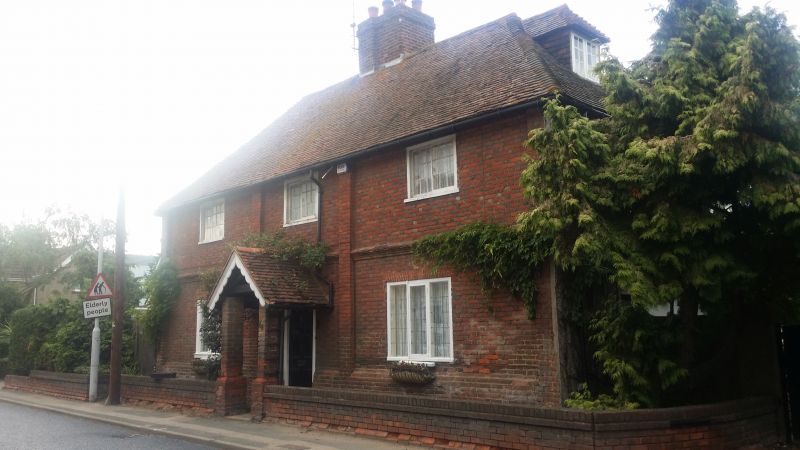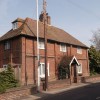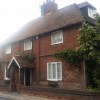Uploader's Comments
The Old Vicarage stands in North Street, Milton Regis not far from the church though separated by a junction. It is red brick with old peg tiled roof. On either side of the front door is a large sitting room. A single story extension, added during the 19th century, runs the length of the house at the back.
1675 The house is built to replace a ‘missing’ vicarage
In John Clancy’s history of Milton church he quotes an interesting passage which says that a new vicarage was built in 1578; this would be the Old Vicarage. He gives no source for the information. I looked at Canterbury Cathedral archives to discover where Clancy had found this information. The archivists were puzzled and then at last we found it: ‘A survey of the estates of the Dean and Chapter of Canterbury was carried out in 1675 by Dean Bargrave.’ It proves that the house was built that year, a hundred years later than is suggested in the Clancy’s history
Hasted tells us that the 1640 vicarage was valued at £80, but over the next thirty years the building fell into disrepair. This covers the time of the Commonwealth when vicars were dispossessed, and so it is easy to see how it could have happened. By the time Thomas Turner became vicar of Milton in 1672, shockingly there was no vicarage left for him to live in. The inhabitants of Milton must have gradually dismantled it for their own use.
When Dean Bargrave arrived at the vicarage in 1675 he found the Rev. Turner away but the parish clerk explained matters to him:
‘We were told that about 30 years ago there was a small Parsonage House but now there is none. Mr Turner, a Scotch man, to whom we gave the vicarage, finding no vicarage house there, sued the executors of Mr Hurst, his predecessor and recovered £30 with which, and his own charge, he was then building a pretty brick vicarage house. Mr Turner being not at home we gave to Mr Taylor, a barber that was churchwarden, 10 shillings to be distributed to the poor.’
(ref Canterbury Cathedral Archives DCc Survey 19)
From this it appears that the previous vicar the Rev. Hurst was responsible for handing over the vicarage in good order but did nothing and must have lived elsewhere. The Dean was told that there were 16 acres of glebe land belonging to the church which were rented out then to a Sittingbourne man to farm. He described Milton as ‘a small market town. It lyeth a mile wide of Sittingbourne, beyond which you turn to it on the right hand towards the sea. Fisher boats come up to it by the tides in a narrow creek of salt water. The church lyeth half a mile off from the town in the fields , to which my brother visitor Dr Aucher and his man walked, I not being able to go by reason of my sickness. The chancel he found in good repair, as likewise two tiled barns.
This describes for us the circumstances of the building of the Old Vicarage and dates it exactly to 1675. The lack of knowledge of the situation by the Dean and Chapter is appalling. It is surprising that the Rev. Turner pursued his predecessor by suing him rather than through the dean and Chapter.
The Rev. Thomas Turner enjoyed the house he had paid to have built until his death twenty years later in 1695. He was followed by the Rev. William Turner vicar of Milton and inhabitant of the house until his death in 1711. He may well have been related to the Rev. Thomas Turner. Then came the Rev. John Smith who was only vicar here for seven years before dying in 1718.
His successor the Rev.Charles Hinde then became vicar of Milton and he and his family lived in the house for quite a number of years until he died in 1751. Unlike his predecessors he left a will in which he asked to be buried in Milton churchyard. He must have been somewhat eccentric since he asked to be buried ‘with my feet turned toward the sycamore tree’. (reference Centre for Kentish Studies PRC17/94/303). He wanted no fuss or expense at his funeral but a plain elm coffin and ‘to be buried in my oldest cloth gown’ with a plain black pall. The will was made a year before his death and he appointed his wife Elizabeth to be his executor and to have all his worldly goods apart from a diamond ring which his daughter Elizabeth was to have and which ‘has been sometime in her custody’, along with a book called the ‘Whole Duty of Man’. He also asked his daughter to ‘be kind to her poor mother who has taken great care of her and to her poor brother and sister.’ The only other bequests were a pair of shammy gloves and a silk coat band to the minister who would take the funeral, 2/6d to the parish clerk and two shillings each to eight poor men for carrying the coffin.
The Rev. Francis Gregory followed Charles Hinde as vicar of Milton, living in the house for 13 years before moving on to another parish. He was succeeded by the splendidly named Osmond Beauvoir who lived here for 36 years until his death. The Rev. John Rose came to live here next but only stayed for two years. Then in 1792 came the Rev. Henry John Todd for nine years and then the last vicar to live in the house the Rev. Edward Walsby.
1805 the house ceases to be a vicarage
‘ The 1500 year history of Holy Trinity Church Milton Regis’, by John Clancy, explains that the Old Vicarage ceased to be used as a vicarage as long ago as 1805. This was due to the fact that the then vicar the Rev. Edward Walsby, who must have been a man with social pretensions, found the house too small to put up visitors. He moved into a 12 bedroomed house down the road in Vicarage Road where Dyngley Close stands now. It was a seventeenth century house, demolished in 1970 due to its poor condition and replaced by the present modern vicarage. . I have not been able to find any documentary evidence that the Old Vicarage ceased to be the vicarage in 1805 at Maidstone or Canterbury archives. Nonetheless it was certainly true by 1839 when the tithe map was made and so the date could well be correct.
The 1839 tithe map for Milton shows the house as number 62 on the map. The accompanying tithe apportionment tells us that William Ismay was the tenant farmer who lived in it. The property belonged to Baroness Wenman who was the lady of the manor. Ismay was a farmer who farmed 436 acres of Milton land (the land of Church farm), from the house. then known as North Street House all owned by Baroness Wenman. There was no land with the house apart from the garden. The map clearly shows a terrace of three cottages beside the house towards the church. The 1841 census tells us more of William Ismay he was young, only in his twenties and he and his wife Susanna had a baby daughter. They had two servant girls and a young live-in farm labourer. It could well have been in 1805 when the last vicar moved out of the house, that the property was sold by Canterbury Dean and Chapter, but they have no record of it.
Over the next ten years Ismay moved his wife and growing family up the road to Church Farm (see tithe map) and a farm bailiff moved into the Old Vicarage. In 1861 it is difficult to tell which family lived in the house since all the inhabitants of the 11 houses in the street were farm labourers and the houses unnumbered. But we can surmise that the house was on the decline since in 1871 all the inhabitants of the street were farm labourers too. We know it was being used as rented accommodation for poor people and that few repairs and no improvements would have been carried out. The 1881 census does number North Street, and Thomas Huckstep a farm labourer born at Selling was then renting the house and let a room to another farm labourer. In 1891 a shipwright and his family lived in the house. This was Thomas Cole an Aylesford man, Emma his wife and their children.
By 1897 the ordnance survey map tells us one more cottage had been added to the terrace beside the house and there was now a semi-detached pair of houses on the other side of the house. These were still the only houses on that side of the road in North Street. By using the maps in conjunction with the census returns it is possible to work out who lived in the house then. The numbering of the houses was completely different then of course and census returns didn’t often give street numbers anyway.
Uploaded by Stephen M Goldsmith FIPG - MBGG - KCHS on 26 October 2014



